Publications
Interactive Exploration of Dissipation Element Geometry
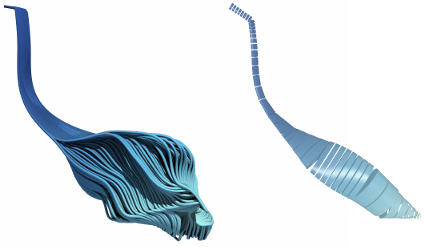
Dissipation elements (DE) define a geometrical structure for the analysis of small-scale turbulence. Existing analyses based on DEs focus on a statistical treatment of large populations of DEs. In this paper, we propose a method for the interactive visualization of the geometrical shape of DE populations. We follow a two-step approach: in a pre-processing step, we approximate individual DEs by tube-like, implicit shapes with elliptical cross sections of varying radii; we then render these approximations by direct ray-casting thereby avoiding the need for costly generation of detailed, explicit geometry for rasterization. Our results demonstrate that the approximation gives a reasonable representation of DE geometries and the rendering performance is suitable for interactive use.
@InProceedings{Vierjahn2017,
booktitle = {Eurographics Symposium on Parallel Graphics and Visualization},
author = {Tom Vierjahn and Andrea Schnorr and Benjamin Weyers and Dominik Denker and Ingo Wald and Christoph Garth and Torsten W. Kuhlen and Bernd Hentschel},
title = {Interactive Exploration of Dissipation Element Geometry},
year = {2017},
pages = {53--62},
ISSN = {1727-348X},
ISBN = {978-3-03868-034-5},
doi = {10.2312/pgv.20171093},
}
A Task-Based Parallel Rendering Component For Large-Scale Visualization Applications
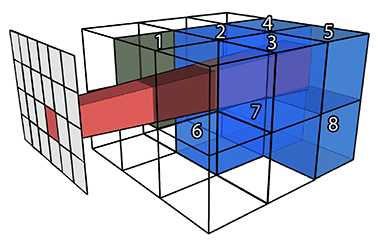
An increasingly heterogeneous system landscape in modern high performance computing requires the efficient and portable adaption of performant algorithms to diverse architectures. However, classic hybrid shared-memory/distributed systems are designed and tuned towards specific platforms, thus impeding development, usage and optimization of these approaches with respect to portability. We demonstrate a flexible parallel rendering framework built upon a task-based dynamic runtime environment enabling adaptable performance-oriented deployment on various platform configurations. Our task definition represents an effective and easy-to-control trade-off between sort-first and sort-last image compositing, enabling good scalability in combination with inherent dynamic load balancing. We conduct comprehensive benchmarks to verify the characteristics and potential of our novel task-based system design for high-performance visualization.
@inproceedings {Biedert2017,
booktitle = {Eurographics Symposium on Parallel Graphics and Visualization},
title = {{A Task-Based Parallel Rendering Component For Large-Scale Visualization Applications}},
author = {Biedert, Tim and Werner, Kilian and Hentschel, Bernd and Garth, Christoph},
year = {2017},
pages = {63--71},
ISSN = {1727-348X},
ISBN = {978-3-03868-034-5},
DOI = {10.2312/pgv.20171094}
}
Measuring Insight into Multi-dimensional Data from a Combination of a Scatterplot Matrix and a HyperSlice Visualization
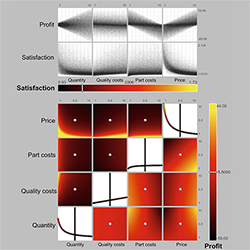
Understanding multi-dimensional data and in particular multi-dimensional dependencies is hard. Information visualization can help to understand this type of data. Still, the problem of how users gain insights from such visualizations is not well understood. Both the visualizations and the users play a role in understanding the data. In a case study, using both, a scatterplot matrix and a HyperSlice with six-dimensional data, we asked 16 participants to think aloud and measured insights during the process of analyzing the data. The amount of insights was strongly correlated with spatial abilities. Interestingly, all users were able to complete an optimization task independently of self-reported understanding of the data.
@Inbook{CaleroValdez2017,
author="Calero Valdez, Andr{\'e}
and Gebhardt, Sascha
and Kuhlen, Torsten W.
and Ziefle, Martina",
editor="Duffy, Vincent G.",
title="Measuring Insight into Multi-dimensional Data from a Combination of a Scatterplot Matrix and a HyperSlice Visualization",
bookTitle="Digital Human Modeling. Applications in Health, Safety, Ergonomics, and Risk Management: Health and Safety: 8th International Conference, DHM 2017, Held as Part of HCI International 2017, Vancouver, BC, Canada, July 9-14, 2017, Proceedings, Part II",
year="2017",
publisher="Springer International Publishing",
address="Cham",
pages="225--236",
isbn="978-3-319-58466-9",
doi="10.1007/978-3-319-58466-9_21",
url="http://dx.doi.org/10.1007/978-3-319-58466-9_21"
}
Interactive Level-of-Detail Visualization of 3D-Polarized Light Imaging Data Using Spherical Harmonics
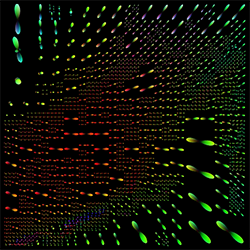
3D-Polarized Light Imaging (3D-PLI) provides data that enables an exploration of brain fibers at very high resolution. However, the visualization poses several challenges. Beside the huge data set sizes, users have to visually perceive the pure amount of information which might be, among other aspects, inhibited for inner structures because of occlusion by outer layers of the brain. We propose a clustering of fiber directions by means of spherical harmonics using a level-of-detail structure by which the user can interactively choose a clustering degree according to the zoom level or details required. Furthermore, the clustering method can be used for the automatic grouping of similar spherical harmonics automatically into one representative. An optional overlay with a direct vector visualization of the 3D-PLI data provides a better anatomical context.
Honorable Mention for Best Short Paper!
@inproceedings {Haenel2017Interactive,
booktitle = {EuroVis 2017 - Short Papers},
editor = {Barbora Kozlikova and Tobias Schreck and Thomas Wischgoll},
title = {{Interactive Level-of-Detail Visualization of 3D-Polarized Light Imaging Data Using Spherical Harmonics}},
author = {H\”anel, Claudia and Demiralp, Ali C. and Axer, Markus and Gr\”assel, David and Hentschel, Bernd and Kuhlen, Torsten W.},
year = {2017},
publisher = {The Eurographics Association},
ISBN = {978-3-03868-043-7},
DOI = {10.2312/eurovisshort.20171145}
}
Comparison of a speech-based and a pie-menu-based interaction metaphor for application control
Choosing an adequate system control technique is crucial to support complex interaction scenarios in virtual reality applications. In this work, we compare an existing hierarchical pie-menu-based approach with a speech-recognition-based one in terms of task performance and user experience in a formal user study. As testbed, we use a factory planning application featuring a large set of system control options.
@INPROCEEDINGS{Pick:691795,
author = {Pick, Sebastian and Puika, Andrew S. and Kuhlen, Torsten},
title = {{C}omparison of a speech-based and a pie-menu-based
interaction metaphor for application control},
address = {Piscataway, NJ},
publisher = {IEEE},
reportid = {RWTH-2017-06169},
pages = {381-382},
year = {2017},
comment = {2017 IEEE Virtual Reality (VR) : proceedings : March 18-22,
2017, Los Angeles, CA, USA / Evan Suma Rosenberg, David M.
Krum, Zachary Wartell, Betty Mohler, Sabarish V. Babu, Frank
Steinicke, and Victoria Interrante ; sponsored by IEEE
Computer Society, Visialization and Graphics Technical
Committee},
booktitle = {2017 IEEE Virtual Reality (VR) :
proceedings : March 18-22, 2017, Los
Angeles, CA, USA / Evan Suma Rosenberg,
David M. Krum, Zachary Wartell, Betty
Mohler, Sabarish V. Babu, Frank
Steinicke, and Victoria Interrante ;
sponsored by IEEE Computer Society,
Visialization and Graphics Technical
Committee},
month = {Mar},
date = {2017-03-18},
organization = {2017 IEEE Virtual Reality, Los
Angeles, CA (USA), 18 Mar 2017 - 22 Mar
2017},
cin = {124620 / 120000 / 080025},
cid = {$I:(DE-82)124620_20151124$ / $I:(DE-82)120000_20140620$ /
$I:(DE-82)080025_20140620$},
pnm = {B-1 - Virtual Production Intelligence},
pid = {G:(DE-82)X080025-B-1},
typ = {PUB:(DE-HGF)7 / PUB:(DE-HGF)8},
UT = {WOS:000403149400114},
doi = {10.1109/VR.2017.7892336},
url = {http://publications.rwth-aachen.de/record/691795},
}
buenoSDIAs: Supporting Desktop Immersive Analytics While Actively Preventing Cybersickness
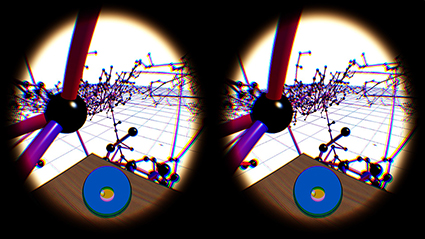
Immersive data analytics as an emerging research topic in scientific and information visualization has recently been brought back into the focus due to the emergence of low-cost consumer virtual reality hardware. Previous research has shown the positive impact of immersive visualization on data analytics workflows, but in most cases, insights were based on large-screen setups. In contrast, less research focuses on a close integration of immersive technology into existing, i.e., desktop-based data analytics workflows. This implies specific requirements regarding the usability of such systems, which include, i.e., the prevention of cybersickness. In this work, we present a prototypical application, which offers a first set of tools and addresses major challenges for a fully immersive data analytics setting in which the user is sitting at a desktop. In particular, we address the problem of cybersickness by integrating prevention strategies combined with individualized user profiles to maximize time of use.
Utilizing Immersive Virtual Reality in Everyday Work
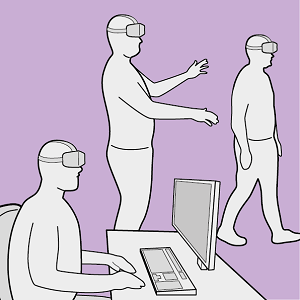
Applications of Virtual Reality (VR) have been repeatedly explored with the goal to improve the data analysis process of users from different application domains, such as architecture and simulation sciences. Unfortunately, making VR available in professional application scenarios or even using it on a regular basis has proven to be challenging. We argue that everyday usage environments, such as office spaces, have introduced constraints that critically affect the design of interaction concepts since well-established techniques might be difficult to use. In our opinion, it is crucial to understand the impact of usage scenarios on interaction design, to successfully develop VR applications for everyday use. To substantiate our claim, we define three distinct usage scenarios in this work that primarily differ in the amount of mobility they allow for. We outline each scenario's inherent constraints but also point out opportunities that may be used to design novel, well-suited interaction techniques for different everyday usage environments. In addition, we link each scenario to a concrete application example to clarify its relevance and show how it affects interaction design.
Efficient Approximate Computation of Scene Visibility Based on Navigation Meshes and Applications for Navigation and Scene Analysis
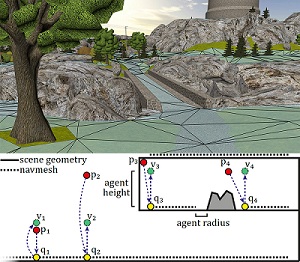
Scene visibility - the information of which parts of the scene are visible from a certain location—can be used to derive various properties of a virtual environment. For example, it enables the computation of viewpoint quality to determine the informativeness of a viewpoint, helps in constructing virtual tours, and allows to keep track of the objects a user may already have seen. However, computing visibility at runtime may be too computationally expensive for many applications, while sampling the entire scene beforehand introduces a costly precomputation step and may include many samples not needed later on.
Therefore, in this paper, we propose a novel approach to precompute visibility information based on navigation meshes, a polygonal representation of a scene’s navigable areas. We show that with only limited precomputation, high accuracy can be achieved in these areas. Furthermore, we demonstrate the usefulness of the approach by means of several applications, including viewpoint quality computation, landmark and room detection, and exploration assistance. In addition, we present a travel interface based on common visibility that we found to result in less cybersickness in a user study.
» Show BibTeX
@INPROCEEDINGS{freitag2017a,
author={Sebastian Freitag and Benjamin Weyers and Torsten W. Kuhlen},
booktitle={2017 IEEE Symposium on 3D User Interfaces (3DUI)},
title={{Efficient Approximate Computation of Scene Visibility Based on Navigation Meshes and Applications for Navigation and Scene Analysis}},
year={2017},
pages={134--143},
}
Approximating Optimal Sets of Views in Virtual Scenes
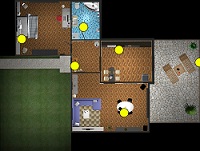
Viewpoint quality estimation methods allow the determination of the most informative position in a scene. However, a single position usually cannot represent an entire scene, requiring instead a set of several viewpoints. Measuring the quality of such a set of views, however, is not trivial, and the computation of an optimal set of views is an NP-hard problem. Therefore, in this work, we propose three methods to estimate the quality of a set of views. Furthermore, we evaluate three approaches for computing an approximation to the optimal set (two of them new) regarding effectiveness and efficiency.
Assisted Travel Based on Common Visibility and Navigation Meshes
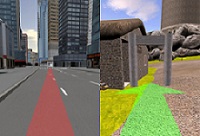
The manual adjustment of travel speed to cover medium or large distances in virtual environments may increase cognitive load, and manual travel at high speeds can lead to cybersickness due to inaccurate steering. In this work, we present an approach to quickly pass regions where the environment does not change much, using automated suggestions based on the computation of common visibility. In a user study, we show that our method can reduce cybersickness when compared with manual speed control.
BlowClick 2.0: A Trigger Based on Non-Verbal Vocal Input
The use of non-verbal vocal input (NVVI) as a hand-free trigger approach has proven to be valuable in previous work [Zielasko2015]. Nevertheless, BlowClick's original detection method is vulnerable to false positives and, thus, is limited in its potential use, e.g., together with acoustic feedback for the trigger. Therefore, we extend the existing approach by adding common machine learning methods. We found that a support vector machine (SVM) with Gaussian kernel performs best for detecting blowing with at least the same latency and more precision as before. Furthermore, we added acoustic feedback to the NVVI trigger, which increases the user's confidence. To evaluate the advanced trigger technique, we conducted a user study (n=33). The results confirm that it is a reliable trigger; alone and as part of a hands-free point-and-click interface.
A Reliable Non-Verbal Vocal Input Metaphor for Clicking

We extended BlowClick, a NVVI metaphor for clicking, by adding machine learning methods to more reliably classify blowing events. We found a support vector machine with Gaussian kernel performing the best with at least the same latency and more precision than before. Furthermore, we added acoustic feedback to the NVVI trigger, which increases the user's confidence. With this extended technique we conducted a user study with 33 participants and could confirm that it is possible to use NVVI as a reliable trigger as part of a hands-free point-and-click interface.
Remain Seated: Towards Fully-Immersive Desktop VR
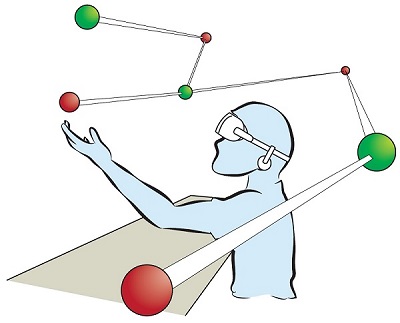
In this work we describe the scenario of fully-immersive desktop VR, which serves the overall goal to seamlessly integrate with existing workflows and workplaces of data analysts and researchers, such that they can benefit from the gain in productivity when immersed in their data-spaces. Furthermore, we provide a literature review showing the status quo of techniques and methods available for realizing this scenario under the raised restrictions. Finally, we propose a concept of an analysis framework and the decisions made and the decisions still to be taken, to outline how the described scenario and the collected methods are feasible in a real use case.
Evaluation of Approaching-Strategies of Temporarily Required Virtual Assistants in Immersive Environments
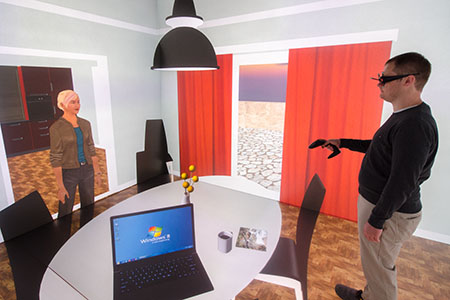
Embodied, virtual agents provide users assistance in agent-based support systems. To this end, two closely linked factors have to be considered for the agents’ behavioral design: their presence time (PT), i.e., the time in which the agents are visible, and the approaching time (AT), i.e., the time span between the user’s calling for an agent and the agent’s actual availability.
This work focuses on human-like assistants that are embedded in immersive scenes but that are required only temporarily. To the best of our knowledge, guidelines for a suitable trade-off between PT and AT of these assistants do not yet exist. We address this gap by presenting the results of a controlled within-subjects study in a CAVE. While keeping a low PT so that the agent is not perceived as annoying, three strategies affecting the AT, namely fading, walking, and running, are evaluated by 40 subjects. The results indicate no clear preference for either behavior. Instead, the necessity of a better trade-off between a low AT and an agent’s realistic behavior is demonstrated.
@InProceedings{Boensch2017b,
Title = {Evaluation of Approaching-Strategies of Temporarily Required Virtual Assistants in Immersive Environments},
Author = {Andrea B\"{o}nsch and Tom Vierjahn and Torsten W. Kuhlen},
Booktitle = {IEEE Symposium on 3D User Interfaces},
Year = {2017},
Pages = {69-72}
}
Gistualizer: An Immersive Glyph for Multidimensional Datapoints
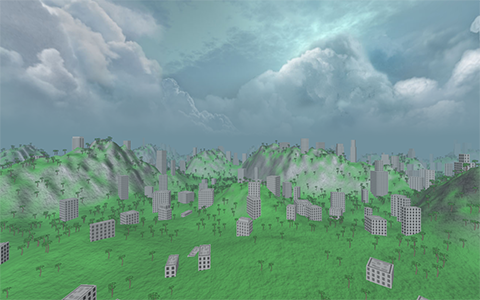
Data from diverse workflows is often too complex for an adequate analysis without visualization. One kind of data are multi-dimensional datasets, which can be visualized via a wide array of techniques. For instance, glyphs can be used to visualize individual datapoints. However, glyphs need to be actively looked at to be comprehended. This work explores a novel approach towards visualizing a single datapoint, with the intention of increasing the user’s awareness of it while they are looking at something else. The basic concept is to represent this point by a scene that surrounds the user in an immersive virtual environment. This idea is based on the observation that humans can extract low-detailed information, the so-called gist, from a scene nearly instantly (equal or less 100ms). We aim at providing a first step towards answering the question whether enough information can be encoded in the gist of a scene to represent a point in multi-dimensional space and if this information is helpful to the user’s understanding of this space.
@inproceedings{Bellgardt2017,
author = {Bellgardt, Martin and Gebhardt, Sascha and Hentschel, Bernd and Kuhlen, Torsten W.},
booktitle = {Workshop on Immersive Analytics},
title = {{Gistualizer: An Immersive Glyph for Multidimensional Datapoints}},
year = {2017}
}
Turning Anonymous Members of a Multiagent System into Individuals
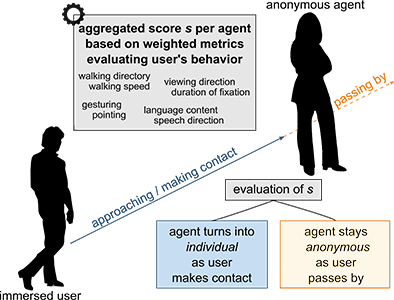
It is increasingly common to embed embodied, human-like, virtual agents into immersive virtual environments for either of the two use cases: (1) populating architectural scenes as anonymous members of a crowd and (2) meeting or supporting users as individual, intelligent and conversational agents. However, the new trend towards intelligent cyber physical systems inherently combines both use cases. Thus, we argue for the necessity of multiagent systems consisting of anonymous and autonomous agents, who temporarily turn into intelligent individuals. Besides purely enlivening the scene, each agent can thus be engaged into a situation-dependent interaction by the user, e.g., into a conversation or a joint task. To this end, we devise components for an agent’s behavioral design modeling the transition between an anonymous and an individual agent when a user approaches.
@InProceedings{Boensch2017c,
Title = {{Turning Anonymous Members of a Multiagent System into Individuals}},
Author = {Andrea B\"{o}nsch, Tom Vierjahn, Ari Shapiro and Torsten W. Kuhlen},
Booktitle = {IEEE Virtual Humans and Crowds for Immersive Environments},
Year = {2017},
Keywords = {Virtual Humans; Virtual Reality; Intelligent Agents; Mutliagent System},
DOI ={ 10.1109/VHCIE.2017.7935620}
Owner = {ab280112},
Timestamp = {2017.02.28}
}
Poster: Score-Based Recommendation for Efficiently Selecting Individual Virtual Agents in Multi-Agent Systems
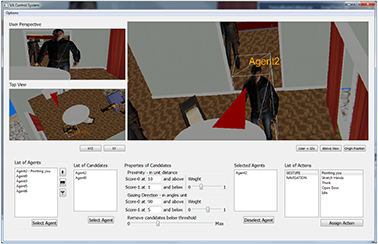
Controlling user-agent-interactions by means of an external operator includes selecting the virtual interaction partners fast and faultlessly. However, especially in immersive scenes with a large number of potential partners, this task is non-trivial.
Thus, we present a score-based recommendation system supporting an operator in the selection task. Agents are recommended as potential partners based on two parameters: the user’s distance to the agents and the user’s gazing direction. An additional graphical user interface (GUI) provides elements for configuring the system and for applying actions to those agents which the operator has confirmed as interaction partners.
@InProceedings{Boensch2017d,
Title = {Score-Based Recommendation for Efficiently Selecting Individual
Virtual Agents in Multi-Agent Systems},
Author = {Andrea Bönsch and Robert Trisnadi and Jonathan Wendt and Tom Vierjahn, and Torsten
W. Kuhlen},
Booktitle = {Proceedings of 23rd ACM
Symposium on Virtual Reality Software and Technology},
Year = {2017},
Pages = {tba},
DOI={10.1145/3139131.3141215}
}
Poster: Towards a Design Space Characterizing Workflows that Take Advantage of Immersive Visualization
Immersive visualization (IV) fosters the creation of mental images of a data set, a scene, a procedure, etc. We devise an initial version of a design space for categorizing workflows that take advantage of IV. From this categorization, specific requirements for seamlessly integrating IV can be derived. We validate the design space with three workflows emerging from our research projects.
@InProceedings{Vierjahn2017,
Title = {Towards a Design Space Characterizing Workflows that Take Advantage of Immersive Visualization},
Author = {Tom Vierjahn and Daniel Zielasko and Kees van Kooten and Peter Messmer and Bernd Hentschel and Torsten W. Kuhlen and Benjamin Weyers},
Booktitle = {IEEE Virtual Reality Conference Poster Proceedings},
Year = {2017},
Pages = {329-330},
DOI={10.1109/VR.2017.7892310}
}
Poster: Peers At Work: Economic Real-Effort Experiments In The Presence of Virtual Co-Workers
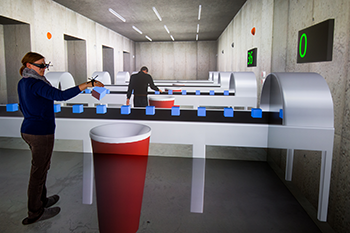
Traditionally, experimental economics uses controlled and incentivized field and lab experiments to analyze economic behavior. However, investigating peer effects in the classic settings is challenging due to the reflection problem: Who is influencing whom?
To overcome this, we enlarge the methodological toolbox of these experiments by means of Virtual Reality. After introducing and validating a real-effort sorting task, we embed a virtual agent as peer of a human subject, who independently performs an identical sorting task. We conducted two experiments investigating (a) the subject’s productivity adjustment due to peer effects and (b) the incentive effects on competition. Our results indicate a great potential for Virtual-Reality-based economic experiments.
@InProceedings{Boensch2017a,
Title = {Peers At Work: Economic Real-Effort Experiments In The Presence of Virtual Co-Workers},
Author = {Andrea B\"{o}nsch and Jonathan Wendt and Heiko Overath and Özgür Gürerk and Christine Harbring and Christian Grund and Thomas Kittsteiner and Torsten W. Kuhlen},
Booktitle = {IEEE Virtual Reality Conference Poster Proceedings},
Year = {2017},
Pages = {301-302},
DOI = {10.1109/VR.2017.7892296}
}
A Collaborative Simulation-Analysis Workflow for Computational Neuroscience Using HPC
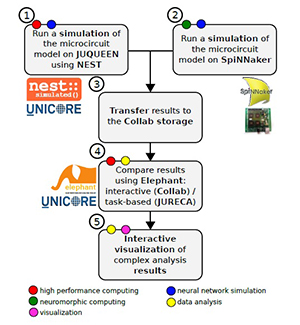
Workflows for the acquisition and analysis of data in the natural sciences exhibit a growing degree of complexity and heterogeneity, are increasingly performed in large collaborative efforts, and often require the use of high-performance computing (HPC). Here, we explore the reasons for these new challenges and demands and discuss their impact, with a focus on the scientific domain of computational neuroscience. We argue for the need for software platforms integrating HPC systems that allow scientists to construct, comprehend and execute workflows composed of diverse processing steps using different tools. As a use case we present a concrete implementation of such a complex workflow, covering diverse topics such as HPC-based simulation using the NEST software, access to the SpiNNaker neuromorphic hardware platform, complex data analysis using the Elephant library, and interactive visualizations. Tools are embedded into a web-based software platform under development by the Human Brain Project, called Collaboratory. On the basis of this implementation, we discuss the state-of-the-art and future challenges in constructing large, collaborative workflows with access to HPC resources.
Virtual Production Intelligence

The research area Virtual Production Intelligence (VPI) focuses on the integrated support of collaborative planning processes for production systems and products. The focus of the research is on processes for information processing in the design domains Factory and Machine. These processes provide the integration and interactive analysis of emerging, mostly heterogeneous planning information. The demonstrators (flapAssist, memoSlice und VPI platform) that are Information systems serve for the validation of the scientific approaches and aim to realize a continuous and consistent information management in terms of the Digital Factory. Central challenges are the semantic information integration (e.g., by means of metamodelling), the subsequent evaluation as well as the visualization of planning information (e.g., by means of Visual Analytics and Virtual Reality). All scientific and technical work is done within an interdisciplinary team composed of engineers, computer scientists and physicists.
@BOOK{Brecher:683508,
key = {683508},
editor = {Brecher, Christian and Özdemir, Denis},
title = {{I}ntegrative {P}roduction {T}echnology : {T}heory and
{A}pplications},
address = {Cham},
publisher = {Springer International Publishing},
reportid = {RWTH-2017-01369},
isbn = {978-3-319-47451-9},
pages = {XXXIX, 1100 Seiten : Illustrationen},
year = {2017},
cin = {417310 / 080025},
cid = {$I:(DE-82)417310_20140620$ / $I:(DE-82)080025_20140620$},
typ = {PUB:(DE-HGF)3},
doi = {10.1007/978-3-319-47452-6},
url = {http://publications.rwth-aachen.de/record/683508},
}
Do Not Invade: A Virtual-Reality-Framework to Study Personal Space
The bachelor thesis’ aim was to develop a framework allowing to design and conduct virtual-reality-based user studies gaining insight into the concept of personal space.
@Article{Schnathmeier2017,
Title = {Do Not Invade: A Virtual-Reality-Framework to Study Personal Space},
Author = {Jan Schnathmeier and Heiko Overath and Sina Radke and Andrea B\"{o}nsch and Ute Habel and Torsten W. Kuhlen},
Journal = {{V}irtuelle und {E}rweiterte {R}ealit\"at, 14. {W}orkshop der {GI}-{F}achgruppe {VR}/{AR}},
Year = {2017},
Pages = {203-204},
ISBN = {978-3-8440-5606-8}
Publisher = {Shaker Verlag}
}
Previous Year (2016)

